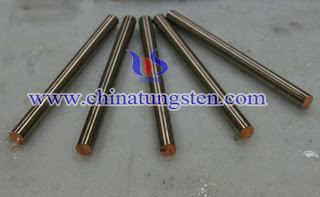Tungsten copper block is made by the material of tungsten and copper, the manufacturring process is pressed tungsten at high temperature, and then infiltrating with copper.
The physical properties of both tungsten and copper make them not mutually soluble, meaning that one cannot be combined with the other, similar to the way oil and water will not mix. The alloy is made by dispersing the particles of one metal into a matrix or crystallized pattern of another. This makes tungsten copper's "micro-structure" or molecular shape that of a metal matrix composite and not of a true alloy.
Tungsten copper is a copper and tungsten alloy that is used to conduct heat and electricity. Tungsten copper consists of 10 to 50 percent of its weight in copper and the remaining portion is made out of tungsten. The lower the copper content, the higher its density and hardness is.
Tungsten copper block advantage.Tungsten Copper Block (WCu80) remains some good characters of tungsten and copper with good high-temperature endurance, reliable electronic arc burning & corrosion endurance, high specific gravity and strong intensity. Tungsten copper block could be used as contacts of high or medium voltage switcher, radiator of electronic components, electronic emission materials, welding electrodes, home appliance and spare parts for clocks.
Tungsten copper block applications: Tungsten copper block could be widely used in the fields of machinery, electric power, electron, metallurgy, aviation and spaceflight. We used HIP molding plant - high temperature sintered tungsten matrix - copper-impregnated technology, can produce copper for 6-50% of the various pieces of large or profiled, the tungsten-copper alloy material we produced has characteristics of high-density, high thermal conductivity, high strength and hardness, low resistivity, low thermal expansion coefficient and easy machining etc, and has excellent performance in areas of the burning arc of resistance, anti-welded and corrosion resistance.
The physical properties of both tungsten and copper make them not mutually soluble, meaning that one cannot be combined with the other, similar to the way oil and water will not mix. The alloy is made by dispersing the particles of one metal into a matrix or crystallized pattern of another. This makes tungsten copper's "micro-structure" or molecular shape that of a metal matrix composite and not of a true alloy.
Tungsten copper is a copper and tungsten alloy that is used to conduct heat and electricity. Tungsten copper consists of 10 to 50 percent of its weight in copper and the remaining portion is made out of tungsten. The lower the copper content, the higher its density and hardness is.
Tungsten copper block advantage.Tungsten Copper Block (WCu80) remains some good characters of tungsten and copper with good high-temperature endurance, reliable electronic arc burning & corrosion endurance, high specific gravity and strong intensity. Tungsten copper block could be used as contacts of high or medium voltage switcher, radiator of electronic components, electronic emission materials, welding electrodes, home appliance and spare parts for clocks.
Tungsten copper block applications: Tungsten copper block could be widely used in the fields of machinery, electric power, electron, metallurgy, aviation and spaceflight. We used HIP molding plant - high temperature sintered tungsten matrix - copper-impregnated technology, can produce copper for 6-50% of the various pieces of large or profiled, the tungsten-copper alloy material we produced has characteristics of high-density, high thermal conductivity, high strength and hardness, low resistivity, low thermal expansion coefficient and easy machining etc, and has excellent performance in areas of the burning arc of resistance, anti-welded and corrosion resistance.
























